Elbow
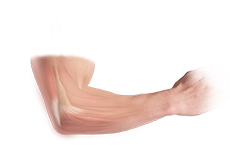
Elbow Anatomy
The elbow is a complex joint formed by the articulation of three bones –the humerus, radius and ulna. The elbow joint helps in bending or straightening of the arm to 180 degrees and assists in lifting or moving objects.
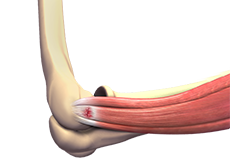
Tennis Elbow
Tennis elbow, also known as lateral epicondylitis, is a degenerative condition affecting the tendons that insert into the bony prominence on the outside (lateral) aspect of the elbow.
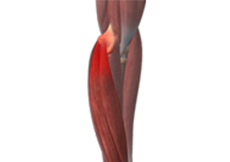
Golfers Elbow
Golfers elbow, also known as medial epicondylitis, is a degenerative condition affecting the tendons which insert into the bony prominence on the inside (medial) aspect of the elbow. It is almost identical to a tennis elbow however unlike a tennis elbow, it affects the inside aspect of the elbow.
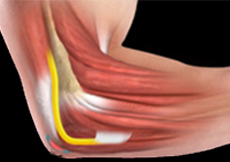
Olecranon Bursitis
The olecranon bursa is a sac like structure that lies over the prominence of the elbow. It naturally contains a small amount of fluid within it such that it helps the skin move freely over the elbow joint. However, as it is so superficial it can easily become irritated and if this continues, inflammation can occur such that an olecranon bursitis develops.
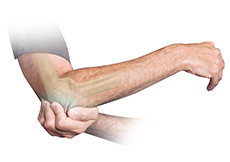
Stiff Elbow
The elbow joint is comprised of three bones; the upper arm bone is called the humerus and the two bones of the forearm are called the radius and ulna. These bones are very closely matched with each other and whilst this does aid stability and excellent function it also makes them prone t injury. In such circumstances stiffness can also develop.
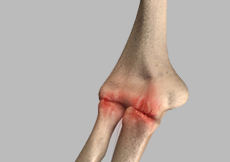
Loose Bodies
The formation of loose bodies in the elbow is usually a sign of degenerative change and osteoarthritis. Their presence can be merely an incidental finding when the elbow is being investigated for pain and stiffness, but they may also cause specific symptoms of locking and episodes of sudden severe pain. If so they can be removed with the size of the loose body will usually dictating the technique needed to remove them. Arthroscopic (key hole) or open techniques may both be used to remove them.

Elbow Arthritis
The elbow is a particularly complicated joint as it involves three bones; the upper arm bone is called the humerus and the two bones of the forearm are called the radius and ulna. The bones of the elbow are perfectly matched to their opposing bones. This helps maintain the elbows stability, which unlike other joints, is involved in both a hinge like movement as well as forearm rotation. This complexity can however make it prone to degenerative conditions such as osteoarthritis, particularly if the joint surfaces are damaged.
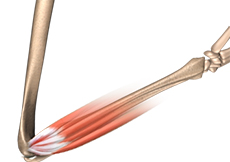
Tennis Elbow Release
The aims of a Tennis Elbow Release is to excise the diseased tendon tissue, which is the perceived source of the pain, and then create an environment for the normal tendon to heal back to the bone. This is done through a small incision, measuring approximately 3-4 cm over the bony prominence on the outer aspect of the elbow. The surgery is usually performed as a day case procedure and you are discharged from hospital in an elbow bandage with a physiotherapy programme which slowly encourages the elbow back to full function over a three month period.

Golfers Elbow Release
The aims of a Golfers Elbow Release is to excise the diseased tendon tissue, which is the perceived source of the pain, and then create an environment for the normal tendon to heal back to the bone. This is done through a small incision, measuring approximately 3-4 cm over the bony prominence on the inner aspect of the elbow. The surgery is usually performed as a day case procedure and you are discharged from hospital in an elbow bandage with a physiotherapy programme which slowly encourages the elbow back to full function over a three month period.

Olecranon Bursectomy
If conservative treatment measures have failed to address a symptomatic olecranon bursitis, then a bursectomy can be performed. An incision, approximately 10cm in length, is made over the back of the elbow and then the bursa is excised. If there is any associated anatomical anomaly that is thought to have caused the bursistis, then it to will be addressed at the same time.

Outerbridge-Kashiwagi (OK) Procedure
The Outerbridge – Kashiwagi (OK) procedure; this procedure is used to debride the elbow joint thereby removing any loose bodies as well as releasing any soft tissue contractures so that any restricted movement can be addressed. It is undertaken as an open procedure through an incision a 10cm incision the back of the elbow, or sometimes as an arthroscopic procedure. A fenestration is made through the bone of humerus from within the elbow joint, so that both the back and front aspects of the joint can be accessed. Any loose bodies, osteophytes and capsular contractions can then removed or released thereby restoring elbow movement.

Elbow Arthrolysis
An elbow debridement and arthrolysis procedure is performed either as a keyhole or open procedure. The aim of the operation is to assess the severity of the cartilage damage of the elbow joint following which any loose bodies and osteophytes can be removed to allow greater movement. At the same time, the capsule enveloping the elbow can be released, which, combined with the osteophyte removal, usually results in an improved range of elbow movement. This is usually undertaken if the stiffness or any associated arthritic change is more advanced such that an Outerbridge-Kashiwagi (OK) procedure is not indicated.

Loose Body Removal
The formation of loose bodies in the elbow is usually a sign of degenerative change and osteoarthritis. Their presence can be merely an incidental finding when the elbow is being investigated for pain and stiffness, but they may also cause specific symptoms of locking and episodes of sudden severe pain. If so they can be removed with the size of the loose body will usually dictating the technique needed to remove them. Arthroscopic (key hole) or open techniques may both be used to remove them.
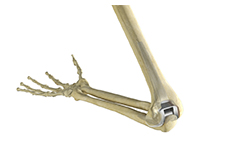
Elbow Replacment
An elbow replacement can come in a variety of different designs.
In early, but significantly symptomatic, disease a lateral elbow replacement can be undertaken. This involves replacing only the capitellum and the radial head. However, the decision to undertake such an operation is still a significant one however it carries with it none of the significant functional restrictions that an elbow replacement has as it is more robust and doesn’t have the same risks of loosening that a conventional total elbow replacement has.





